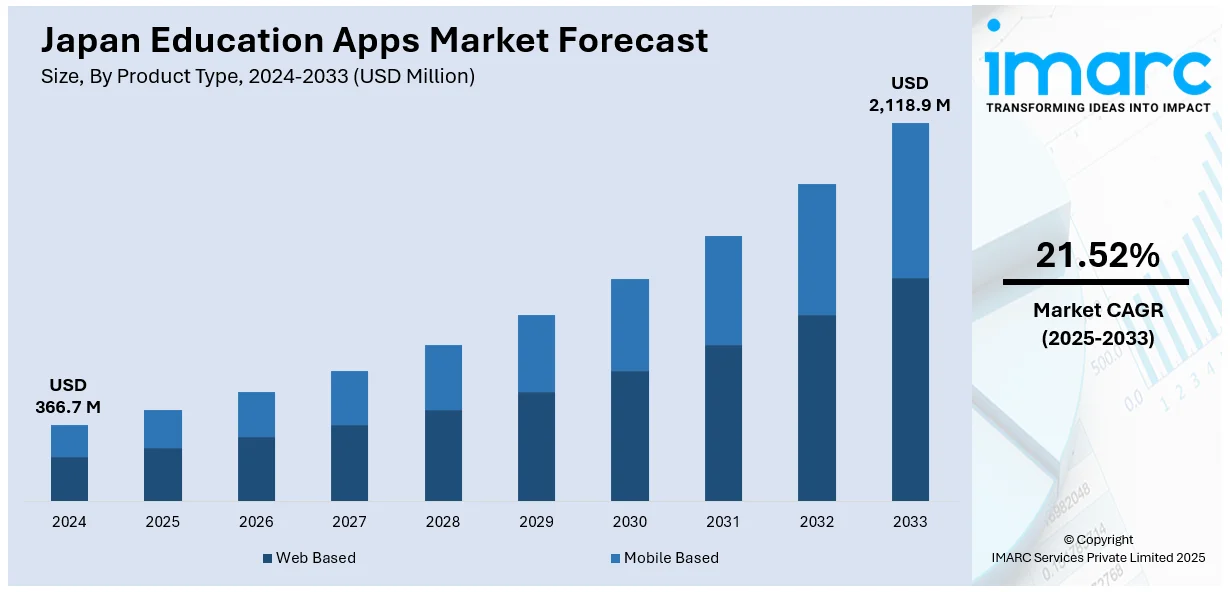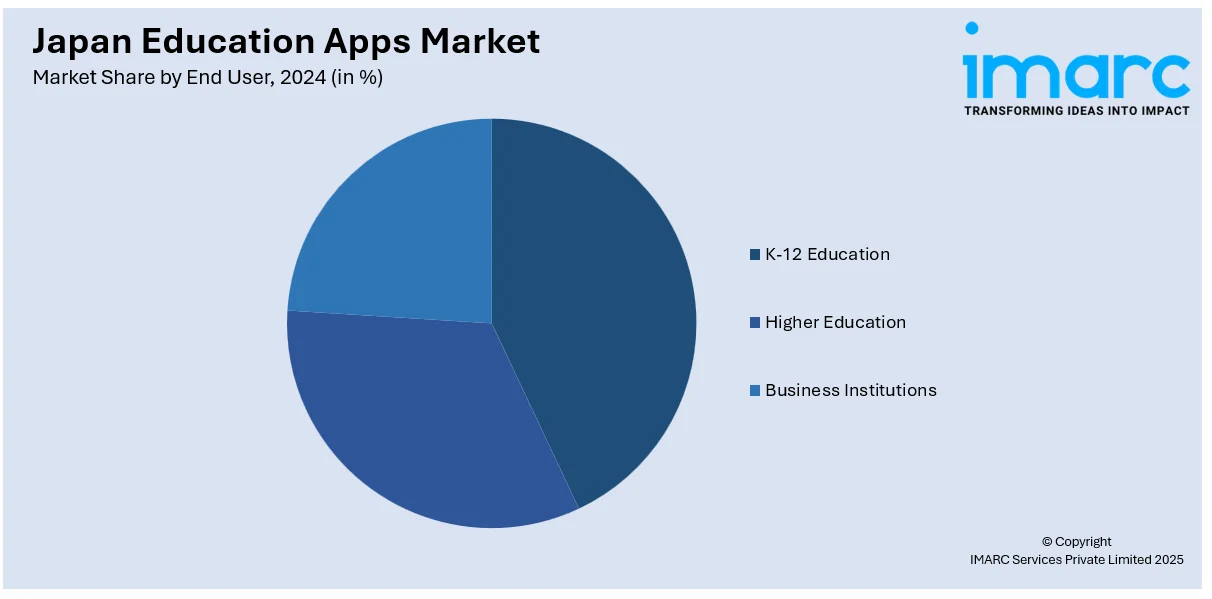
Japan Education Apps Market Size, Share, Trends and Forecast by Product Type, Operating System, End User, and Region, 2025-2033
Japan Education Apps Market Overview:
The Japan education apps market size reached USD 366.7 Million in 2024. Looking forward, IMARC Group expects the market to reach USD 2,118.9 Million by 2033, exhibiting a growth rate (CAGR) of 21.52% during 2025-2033. The market is driven by the heightened digital transformation of the education infrastructure, extensive usage of smartphone and availability of high-speed Internet connection, and increasing focus on personalized learning pathways and academic competitiveness.
|
Report Attribute
|
Key Statistics
|
|---|---|
|
Base Year
|
2024
|
|
Forecast Years
|
2025-2033
|
|
Historical Years
|
2019-2024
|
| Market Size in 2024 | USD 366.7 Million |
| Market Forecast in 2033 | USD 2,118.9 Million |
| Market Growth Rate 2025-2033 | 21.52% |
Japan Education Apps Market Trends:
Digital Transformation in the Education Sector
Japan's education infrastructure is witnessing sweeping digital transformation, driven by initiatives like the GIGA School Program by the government. This initiative by the Ministry of Education, Culture, Sports, Science and Technology (MEXT) seeks to equip each student with a digital device and access high-speed internet connectivity. Large-scale use of information and communications technology (ICT) tools within the classroom is driving the demand for educational apps, particularly those enabling interactive learning, online testing, and customized education trajectories. Additionally, the transition towards hybrid and online learning models is increasing the utilization of apps for instant communication, electronic whiteboarding, and collaborative study. The focus on science, technology, engineering, arts, and mathematics (STEAM) and language education is also encouraging the evolution of apps specialized in coding, design, and problem-solving aptitudes. In 2024, the Human Academy Japanese Language School launched a free trial version of "HAi-J (Human Academy AI Japanese Lesson)", which is the first AI-powered Japanese language learning application.

Increasing Smartphone and Internet Penetration
The extensive smartphone penetration and stable internet connectivity throughout Japan are positively influencing the market. Japan possesses a developed telecommunication infrastructure, with a major portion of its population utilizing smartphones and ubiquitous coverage of high-speed internet. According to Global Data, the number of mobile connections increased by 6.8 million from the start of 2023 to the start of 2024 in Japan. Such digital preparedness is allowing educational providers to serve a large number of users, including students from remote or rural areas. Educational apps take advantage of the mobile-first attitude of users, and most students and parents enjoy learning on-the-go. Push notifications, gamified content, and AI-powered personalization are key features that make users more engaged and retained. Additionally, greater adoption of 5G technology enables smooth streaming of educational content and real-time virtual classrooms, further enhancing the digital learning process.
Rising Demand for Personalized and Supplementary Education
The increasing focus on personalized learning pathways and academic competitiveness is driving the demand for apps that provide customized educational experiences. Japanese parents and students tend to look for additional learning tools to support academic achievement, prepare for entrance exams, or acquire new skills. This demand is catalyzing the need for adaptive learning apps, which employ data analytics and artificial intelligence (AI) algorithms to personalize content according to each student's strengths, weaknesses, and learning speed. In addition, cultural priorities placed on education and a very formalized school environment promote the utilization of after-school programs, many of which now incorporate app-based learning. As a result, companies are creating innovative learning apps to develop talent. In 2024, Pearson Japan K.K., the Japanese subsidiary of London-based education company Pearson PLC, showcased an extensive range of offering at EDIX Tokyo for empowering both businesses and educational institutions with its personalized learning solutions.
Japan Education Apps Market Segmentation:
IMARC Group provides an analysis of the key trends in each segment of the market, along with forecasts at the region level for 2025-2033. Our report has categorized the market based on product type, operating system, and end user.
Product Type Insights:
- Web Based
- Mobile Based
The report has provided a detailed breakup and analysis of the market based on the product type. This includes web based and mobile based.
Operating System Insights:
- IOS and MacOS
- Android
- Windows
A detailed breakup and analysis of the market based on the operating system have also been provided in the report. This includes IOS and MacOS, Android, and Windows.
End User Insights:

- K-12 Education
- Higher Education
- Business Institutions
A detailed breakup and analysis of the market based on the end user have also been provided in the report. This includes K-12 education, higher education, and business institutions.
Regional Insights:
- Kanto Region
- Kansai/Kinki Region
- Central/ Chubu Region
- Kyushu-Okinawa Region
- Tohoku Region
- Chugoku Region
- Hokkaido Region
- Shikoku Region
The report has also provided a comprehensive analysis of all the major regional markets, which include Kanto region, Kansai/Kinki region, Central/ Chubu region. Kyushu-Okinawa region, Tohoku region, Chugoku region, Hokkaido region, and Shikoku region.
Competitive Landscape:
The market research report has also provided a comprehensive analysis of the competitive landscape. Competitive analysis such as market structure, key player positioning, top winning strategies, competitive dashboard, and company evaluation quadrant has been covered in the report. Also, detailed profiles of all major companies have been provided.
Japan Education Apps Market Report Coverage:
| Report Features | Details |
|---|---|
| Base Year of the Analysis | 2024 |
| Historical Period | 2019-2024 |
| Forecast Period | 2025-2033 |
| Units | Million USD |
| Scope of the Report |
Exploration of Historical Trends and Market Outlook, Industry Catalysts and Challenges, Segment-Wise Historical and Future Market Assessment:
|
| Product Types Covered | Web Based, Mobile Based |
| Operating Systems Covered | IOS and MacOS, Android, Windows |
| End Users Covered | K-12 Education, Higher Education, Business Institutions |
| Regions Covered | Kanto Region, Kansai/Kinki Region, Central/ Chubu Region, Kyushu-Okinawa Region, Tohoku Region, Chugoku Region, Hokkaido Region, Shikoku Region |
| Customization Scope | 10% Free Customization |
| Post-Sale Analyst Support | 10-12 Weeks |
| Delivery Format | PDF and Excel through Email (We can also provide the editable version of the report in PPT/Word format on special request) |
Key Questions Answered in This Report:
- How has the Japan education apps market performed so far and how will it perform in the coming years?
- What is the breakup of the Japan education apps market on the basis of product type?
- What is the breakup of the Japan education apps market on the basis of operating system?
- What is the breakup of the Japan education apps market on the basis of end user?
- What is the breakup of the Japan education apps market on the basis of region?
- What are the various stages in the value chain of the Japan education apps market?
- What are the key driving factors and challenges in the Japan education apps?
- What is the structure of the Japan education apps market and who are the key players?
- What is the degree of competition in the Japan education apps market?
Key Benefits for Stakeholders:
- IMARC’s industry report offers a comprehensive quantitative analysis of various market segments, historical and current market trends, market forecasts, and dynamics of the Japan education apps market from 2019-2033.
- The research report provides the latest information on the market drivers, challenges, and opportunities in the Japan education apps market.
- Porter's five forces analysis assist stakeholders in assessing the impact of new entrants, competitive rivalry, supplier power, buyer power, and the threat of substitution. It helps stakeholders to analyze the level of competition within the Japan education apps industry and its attractiveness.
- Competitive landscape allows stakeholders to understand their competitive environment and provides an insight into the current positions of key players in the market.
Need more help?
- Speak to our experienced analysts for insights on the current market scenarios.
- Include additional segments and countries to customize the report as per your requirement.
- Gain an unparalleled competitive advantage in your domain by understanding how to utilize the report and positively impacting your operations and revenue.
- For further assistance, please connect with our analysts.
 Request Customization
Request Customization
 Speak to an Analyst
Speak to an Analyst
 Request Brochure
Request Brochure
 Inquire Before Buying
Inquire Before Buying




.webp)




.webp)












